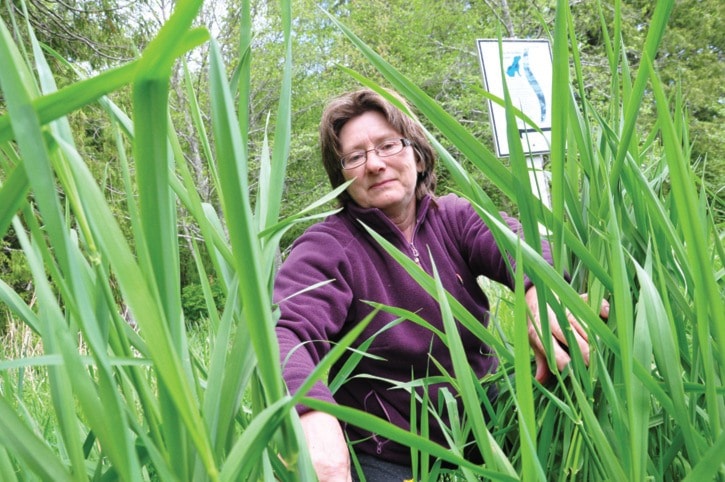A single stalk of reed canary grass pokes through a bed of mulch — a defiant gesture from an aggressive invasive plant.
“One got through,” says Judy Nault, standing over a wide oval of wood chips on the Havenwood property Colwood. “We’ll have to get on that.”
Nault is one of about three volunteers helping eradicate coarse, fast growing reed grass near Bee Creek, a short waterway restored as a fish-bearing stream about four years ago in a $150,000 project.
The canary grass grows fast and tall, Nault says, smothering out native species and degrading the ecosystem that exists alongside the creek. Unlike Scotch broom, snipping reed grass isn’t the strategy — its roots spread too deep and wide.
Instead, the volunteers layer cardboard over the grass and heap earth over top that. Wood chip ovals that dot the picturesque property mark patches of progress.
“Using cardboard smothers (reed grass) completely and it leaves the topsoil there,” says Nault, a retired landscaper who lives in Colwood. “Then we can plant native plants on top.”
That’s theoretical — the volunteers can’t afford to buy native plants.
Three summers ago, the Alberta-based Havenwood developers helped fund reed grass eradication, but these days the group is working off its own steam.
It’s even hard to find enough free cardboard, which she notes, can be used as is, minus any packing tape.
Bee Creek itself originates from wetlands in the surrounding Royal Roads property, snaking its way into the Esquimalt Lagoon. The area was once logged, and the creek, surprisingly for the volume of water that flushes through, once held a small hydroelectric dam.
Nault figures the volunteers have at least two more summers of work along the creek to push back reed grass to allow a more diverse, native habitat to take root. With no money and a small team, Nault says she’s motivated by the notion of caring for the land and habitat for the greater good. It also helps the surrounding estate is akin to a small Garden of Eden, overlooking the lagoon.
“I love this property, it’s such a beautiful place,” she says. “We’re never going to have enough money to pay people — its just too labour intensive. We’ve just got to get back to being stewards of the places where we live.”
Anyone interested in volunteering with Nault can email judynault@telus.net.
editor@goldstreamgazette.com
